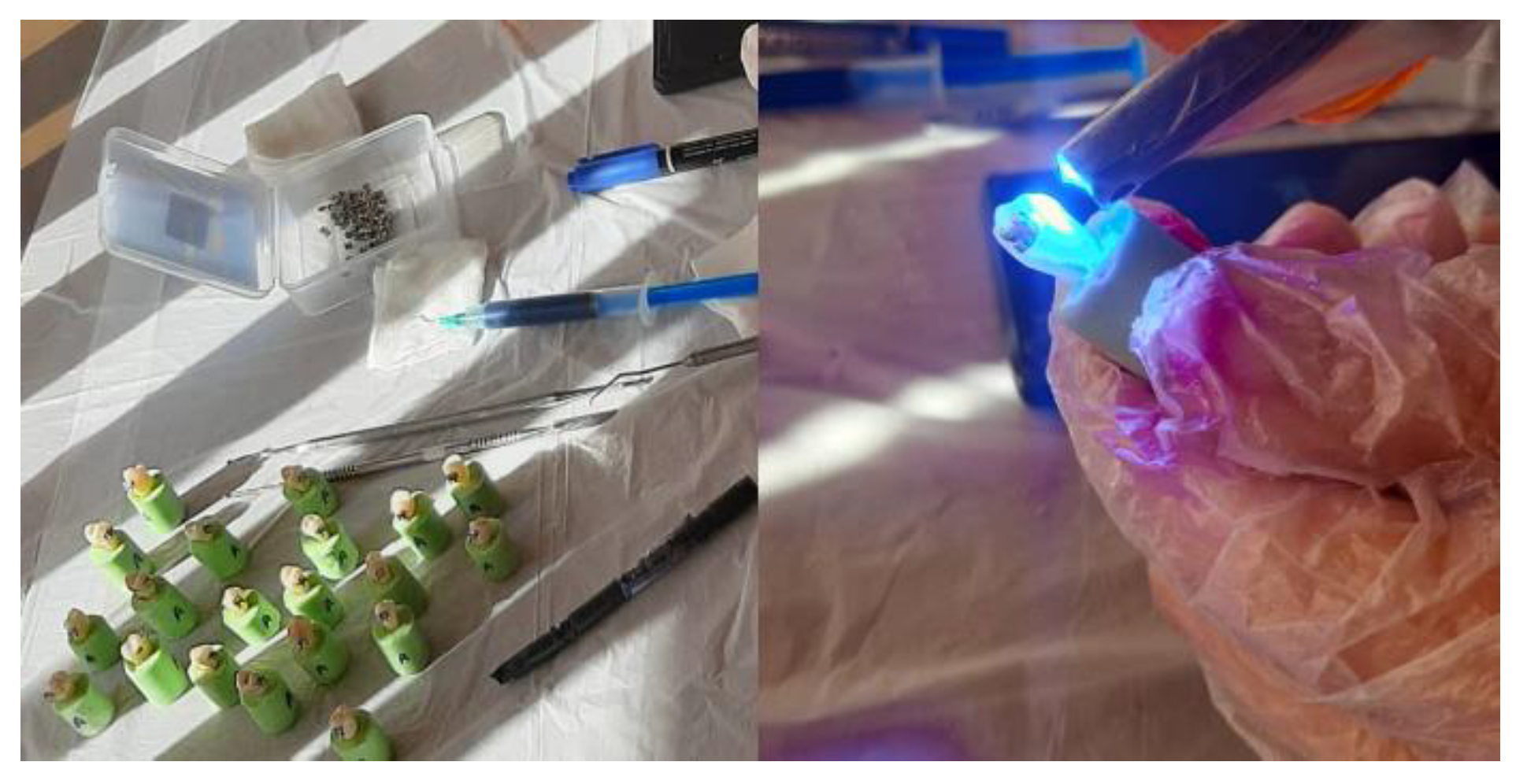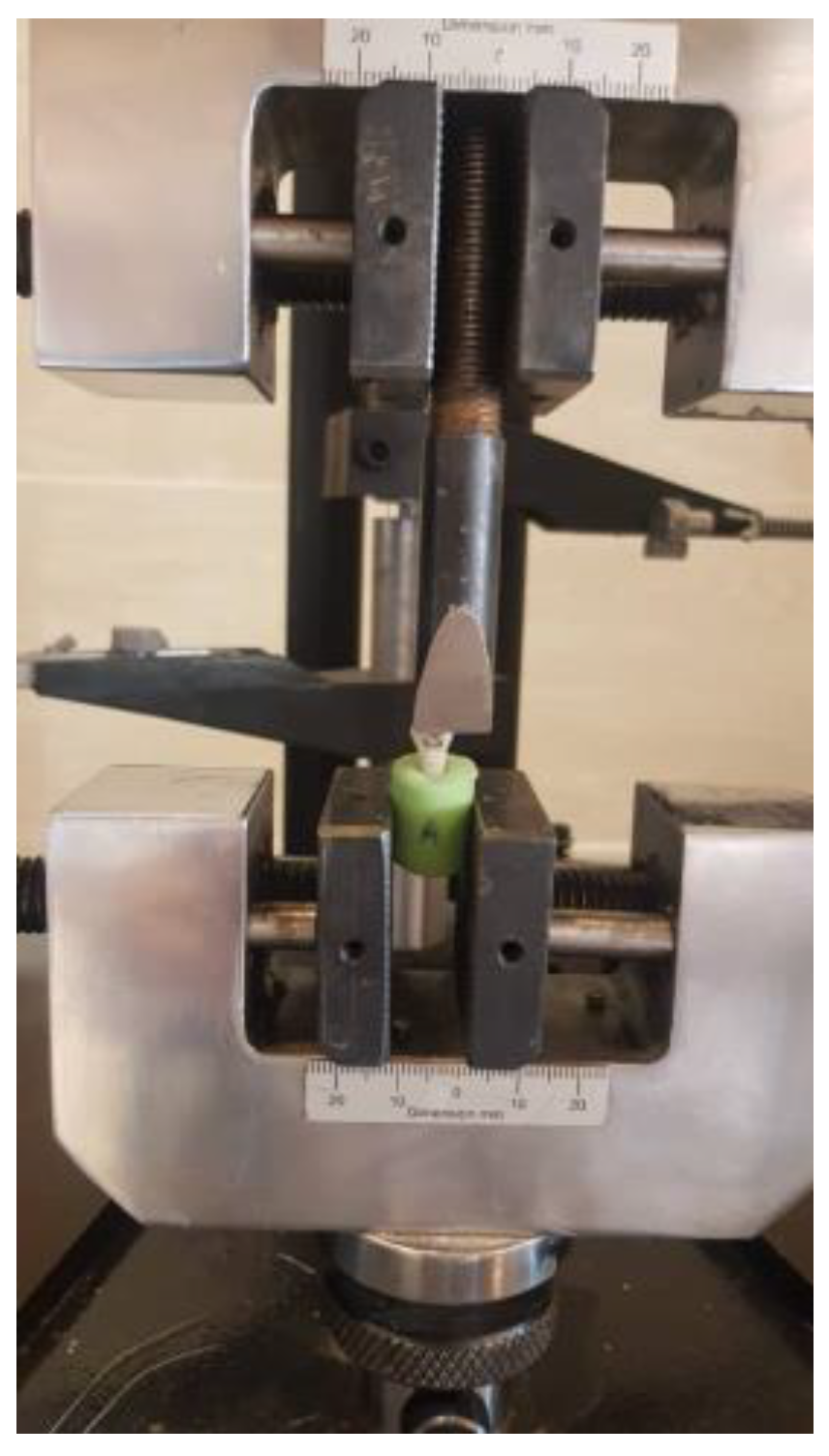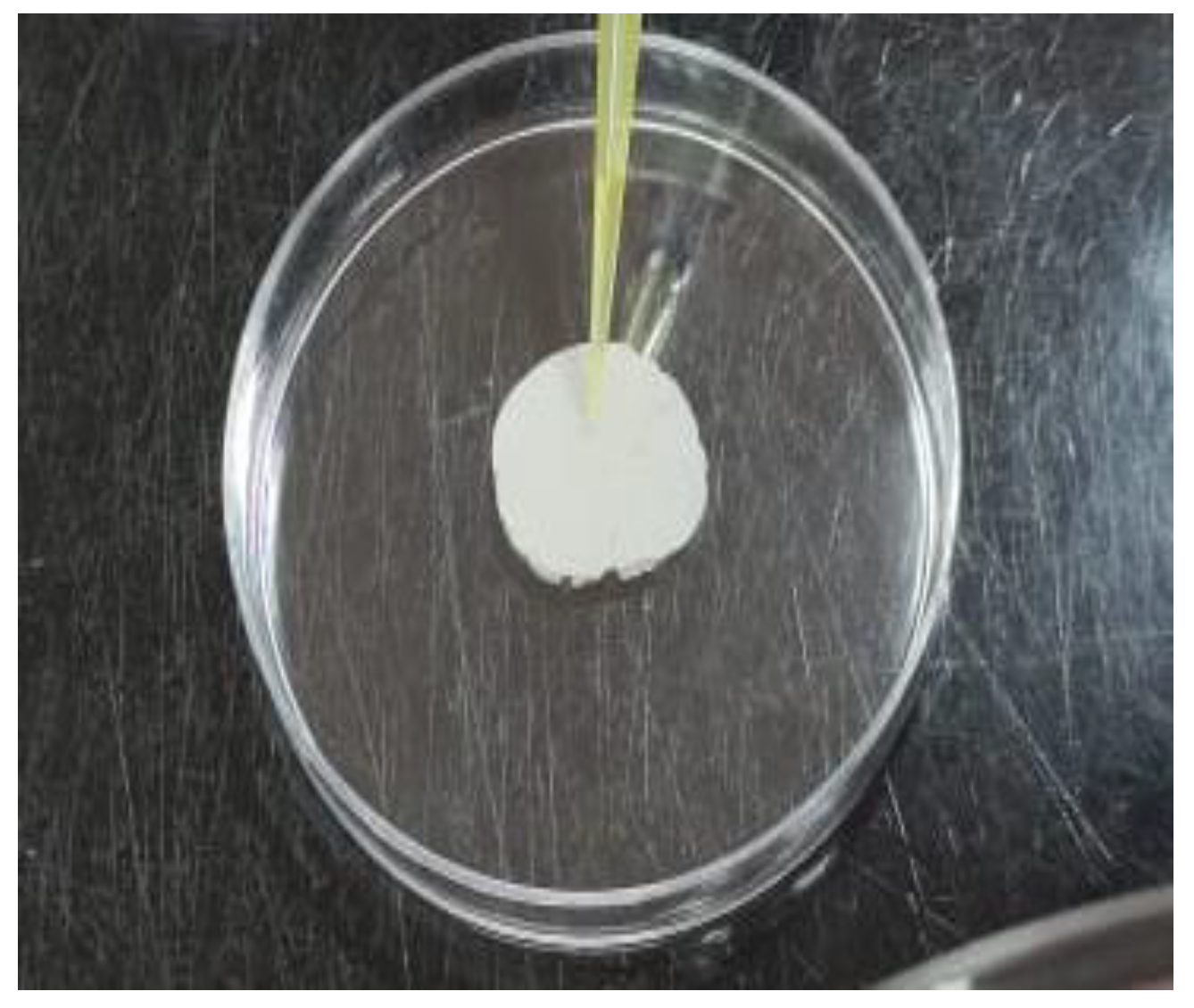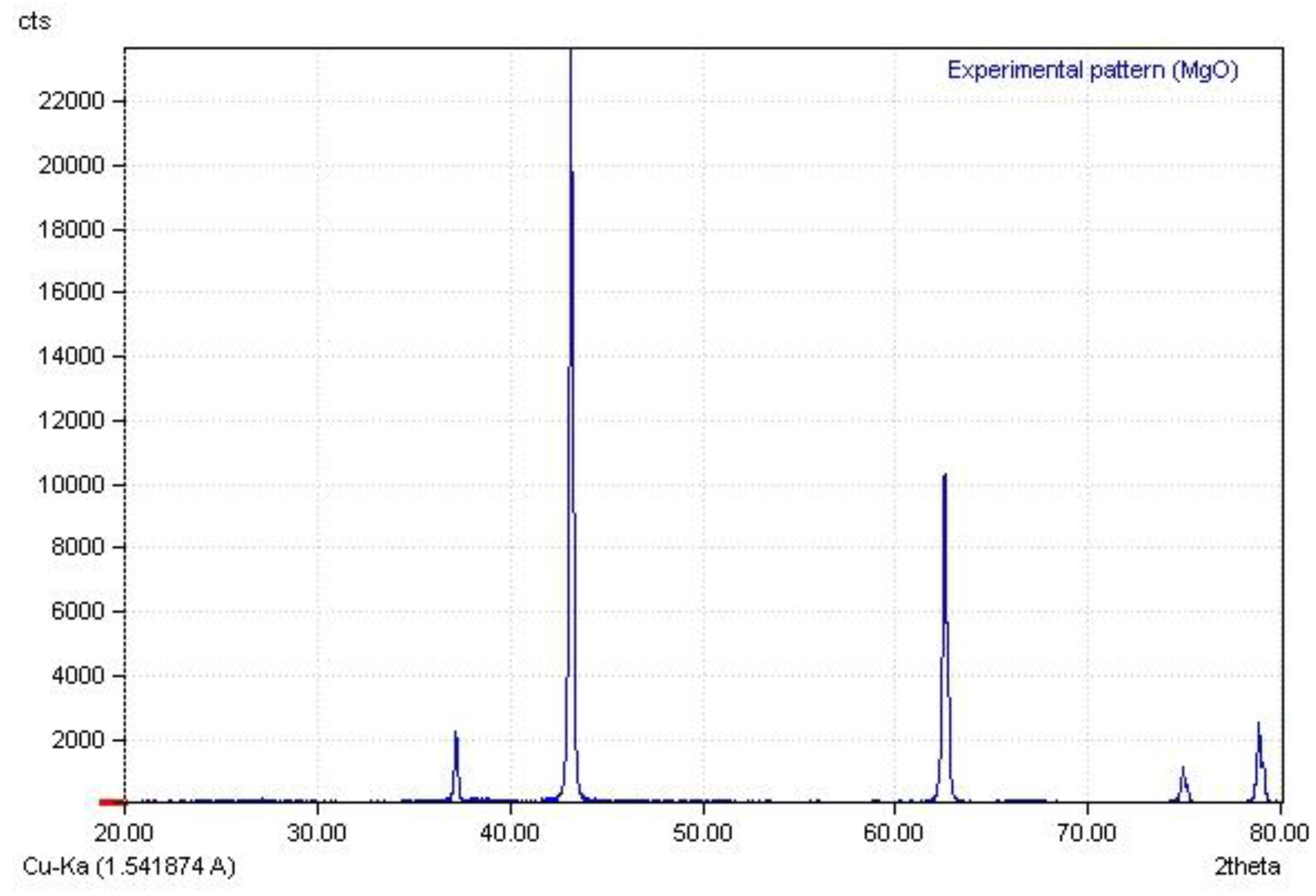Effects of Magnesium Oxide Nanoparticles Incorporation on Shear Bond Strength and Antibacterial Activity of an Orthodontic Composite: An In Vitro Study
Abstract
:1. Introduction
2. Materials and Methods
- The exerted bacteria in this study was S. mutans (PTCC No: 1683).
- The bacteria were procured from the Persian Type Culture Collection (PTCC) and cultured on Brain Heart Infusion Agar (BHIA) that was supplemented with 5% sheep blood plates to be incubated at 37 °C for 48 h.
- The bacteria cells were harvested and resuspended in sterile phosphate-buffered saline (PBS).
- The preparation of bacterial inoculum in the predetermined optical density of 0.5, known as the McFarland standard concentration, was done by dilution that implicated the usage of sterile phosphate-buffered saline (PBS).
- Then, the 0.5 McFarland standard was diluted in the ratio of 1:250 to achieve the bacterial cell concentration of 6 × 105 CFU/mL.
- The samples were decontaminated by the application of ultraviolet (UV) radiation.
- An amount of 100 microliters of the prepared bacterial suspension was pipetted onto the surfaces of the sample. A laboratory glass slide was used as a negative control. Every inoculated surface was placed and kept in a sterile plate for 24 h.
- The samples’ surfaces were washed with liquid culture medium to recover their bacteria. Then, the washing results were cultured on the brain heart infusion agar (BHIA), which was supplemented with 5% sheep blood plates, to be incubated for 48 h.
- The number of colonies per plate was recorded to determine the number of viable bacteria.
3. Results
4. Discussions
5. Conclusions
Author Contributions
Funding
Data Availability Statement
Acknowledgments
Conflicts of Interest
References
- Harikrishnan, P.; Subha, T.S.; Kavitha, V.; Gnanamani, A. Microbial adhesion on orthodontic ligating materials: An in Vitro assessment. Sci. Res. 2013, 3, 29236. [Google Scholar]
- Shimpo, Y.; Nomura, Y.; Sekiya, T.; Arai, C.; Okada, A.; Sogabe, K.; Hanada, N.; Tomonari, H. Effects of the Dental Caries Preventive Procedure on the White Spot Lesions during Orthodontic Treatment—An Open Label Randomized Controlled Trial. J. Clin. Med. 2022, 11, 854. [Google Scholar] [CrossRef] [PubMed]
- Kumar, V.; Singh, P.; Arora, V.K.; Kaur, S.; Sarin, S.; Singh, H. Assessment of effect of fixed orthodontic treatment on gingival health: An observational study. J. Pharm. Bioallied Sci. 2021, 13 (Suppl. 1), S425–S428. [Google Scholar]
- Sundararaj, D.; Venkatachalapathy, S.; Tandon, A.; Pereira, A. Critical evaluation of incidence and prevalence of white spot lesions during fixed orthodontic appliance treatment: A meta-analysis. J. Int. Soc. Prev. Community Dent. 2015, 5, 433–439. [Google Scholar]
- Ogiński, T.; Kawala, B.; Mikulewicz, M.; Antoszewska-Smith, J. A clinical comparison of failure rates of metallic and ceramic brackets: A twelve-month study. BioMed Res. Int. 2020, 2020, 9725101. [Google Scholar] [CrossRef] [PubMed]
- Øgaard, B.; Rølla, G.; Arends, J.; Ten Cate, J. Orthodontic appliances and enamel demineralization Part 2. Prevention and treatment of lesions. Am. J. Orthod. Dentofac. Orthop. 1988, 94, 123–128. [Google Scholar] [CrossRef]
- Siqueira, W.L.; Canales, M.P.; Crosara, K.T.B.; Marin, L.M.; Xiao, Y. Proteome difference among the salivary proteins adsorbed onto metallic orthodontic brackets and hydroxyapatite discs. PLoS ONE 2021, 16, e0254909. [Google Scholar] [CrossRef]
- Heravi, F.; Bagheri, H.; Rangrazi, A.; Zebarjad, S.M. An in vitro study on the retentive strength of orthodontic bands cemented with CPP-ACP-containing GIC. Mater. Res. Express 2016, 3, 125401. [Google Scholar] [CrossRef]
- Kamber, R.; Meyer-Lückel, H.; Kloukos, D.; Tennert, C.; Wierichs, R.J. Efficacy of sealants and bonding materials during fixed orthodontic treatment to prevent enamel demineralization: A systematic review and meta-analysis. Sci. Rep. 2021, 11, 16556. [Google Scholar] [CrossRef]
- Bock, N.C.; Seibold, L.; Heumann, C.; Gnandt, E.; Röder, M.; Ruf, S. Changes in white spot lesions following post-orthodontic weekly application of 1.25 per cent fluoride gel over 6 months—A randomized placebo-controlled clinical trial. Part II: Clinical data evaluation. Eur. J. Orthod. 2017, 39, 144–152. [Google Scholar]
- Benson, P.E.; Parkin, N.; Dyer, F.; Millett, D.T.; Germain, P. Fluorides for preventing early tooth decay (demineralised lesions) during fixed brace treatment. Cochrane Database Syst. Rev. 2019, 2019, 11. [Google Scholar] [CrossRef] [PubMed]
- Ahrari, F.; Hosseini, Z.S.; Hasanzadeh, N.; Ghanbarzadeh, M. In vitro Effects of a Neutral Fluoride Agent on Shear Bond Strength and Microleakage of Orthodontic Brackets. J. Dent. Mater. Tech. 2014, 3, 106–111. [Google Scholar]
- Metin-Gürsoy, G.; Taner, L.; Akca, G. Nanosilver coated orthodontic brackets: In vivo antibacterial properties and ion release. Eur. J. Orthod. 2017, 39, 9–16. [Google Scholar] [CrossRef] [PubMed]
- Farzanegan, F.; Shahabi, M.; Niazi, A.E.; Soleimanpour, S.; Shafaee, H.; Rangrazi, A. Effect of the addition of Chitosan and TiO2 nanoparticles on antibacterial properties of an orthodontic composite in fixed orthodontic treatment: A randomized clinical trial study. Biomed. Phys. Eng. Express 2021, 7, 045017. [Google Scholar] [CrossRef]
- Degrazia, F.W.; Leitune, V.C.B.; Garcia, I.M.; Arthur, R.A.; Samuel, S.M.W.; Collares, F.M. Effect of silver nanoparticles on the physicochemical and antimicrobial properties of an orthodontic adhesive. J. Appl. Oral Sci. 2016, 24, 404–410. [Google Scholar] [CrossRef] [PubMed]
- Toodehzaeim, M.H.; Zandi, H.; Meshkani, H.; Firouzabadi, A.H. The effect of CuO nanoparticles on antimicrobial effects and shear bond strength of orthodontic adhesives. J. Dent. 2018, 19, 1–5. [Google Scholar]
- Poosti, M.; Ramazanzadeh, B.; Zebarjad, M.; Javadzadeh, P.; Naderinasab, M.; Shakeri, M.T. Shear bond strength and antibacterial effects of orthodontic composite containing TiO2 nanoparticles. Eur. J. Orthod. 2013, 35, 676–679. [Google Scholar] [CrossRef]
- Spencer, C.G.; Campbell, P.M.; Buschang, P.H.; Cai, J.; Honeyman, A.L. Antimicrobial effects of zinc oxide in an orthodontic bonding agent. Angle Orthod. 2009, 79, 317–322. [Google Scholar] [CrossRef]
- Sodagar, A.; Bahador, A.; Pourhajibagher, M.; Ahmadi, B.; Baghaeian, P. Effect of addition of curcumin nanoparticles on antimicrobial property and shear bond strength of orthodontic composite to bovine enamel. J. Dent. 2016, 13, 373–382. [Google Scholar]
- Jahanbin, A.; Farzanegan, F.; Atai, M.; Jamehdar, S.A.; Golfakhrabadi, P.; Shafaee, H. A comparative assessment of enamel mineral content and Streptococcus mutans population between conventional composites and composites containing nano amorphous calcium phosphate in fixed orthodontic patients: A split-mouth randomized clinical trial. Eur. J. Orthod. 2017, 39, 43–51. [Google Scholar] [CrossRef]
- Yaseen, S.N.; Taqa, A.A.; Al-Khatib, A.R. The effect of incorporation Nano Cinnamon powder on the shear bond of the orthodontic composite (an in vitro study). J. Oral Biol. Craniofacial Res. 2020, 10, 128–134. [Google Scholar] [CrossRef] [PubMed]
- Noori, A.J.; Kareem, F.A. The effect of magnesium oxide nanoparticles on the antibacterial and antibiofilm properties of glass-ionomer cement. Heliyon 2019, 5, e02568. [Google Scholar] [CrossRef] [PubMed]
- Mazaheri, N.; Naghsh, N.; Karimi, A.; Salavati, H. In vivo toxicity investigation of magnesium oxide nanoparticles in rat for environmental and biomedical applications. Iran. J. Biotechnol. 2019, 17, e1543. [Google Scholar] [CrossRef] [PubMed]
- Heravi, F.; Bagheri, H.; Rangrazi, A.; Zebarjad, S.M. Incorporation of CPP-ACP into luting and lining GIC: Influence on wear rate (in the presence of artificial saliva) and compressive strength. ACS Biomater. Sci. Eng. 2016, 2, 1867–1871. [Google Scholar] [CrossRef]
- Heravi, F.; Bagheri, H.; Rangrazi, A.; Zebarjad, S.M. Effects of the addition of casein phosphopeptide-amorphous calcium phosphate (CPP-ACP) on mechanical properties of luting and lining glass ionomer cement. Mater. Res. Express 2016, 3, 075405. [Google Scholar] [CrossRef]
- Shahabi, M.; Movahedi Fazel, S.; Rangrazi, A. Incorporation of Chitosan Nanoparticles into a Cold-Cure Ortho-Dontic Acrylic Resin: Effects on Mechanical Properties. Biomimetics 2021, 6, 7. [Google Scholar] [CrossRef]
- Salama, F.; Alrejaye, H.; Aldosari, M.; Almosa, N. Shear bond strength of new and rebonded orthodontic brackets to the enamel surfaces. J. Orthod. Sci. 2018, 7, 1–7. [Google Scholar] [CrossRef]
- Akarsu, S.; Buyuk, S.K.; Kucukekenci, A.S. Effects of adhesive systems at different temperatures on the shear bond strength of orthodontic brackets. J. Dent. Res. Dent. Clin. Dent. Prospect. 2019, 13, 103–108. [Google Scholar] [CrossRef]
- Haghshenas, L.; Amini, A.; Bhatti, A.B.; Rahimi, G. In vitro antibacterial biofilm effect of magnesium oxide nanoparticles on Streptococcus mutans. Micro Nano Biomed. 2016, 1, 21–27. [Google Scholar] [CrossRef]
- Cui, T.; Luo, W.; Xu, L.; Yang, B.; Zhao, W.; Cang, H. Progress of antimicrobial discovery against the major cariogenic pathogen Streptococcus mutans. Curr. Issues Mol. Biol. 2019, 32, 601–644. [Google Scholar] [CrossRef]
- Balakrishnan, G.; Velavan, R.; Batoo, K.M.; Raslan, E.H. Microstructure, optical and photocatalytic properties of MgO nanoparticles. Results Phys. 2020, 16, 103013. [Google Scholar] [CrossRef]
- Farzanegan, F.; Shafaee, H.; Darroudi, M.; Rangrazi, A. Effect of the Incorporation of Chitosan and TiO2 Nanoparticles on the Shear Bond Strength of an Orthodontic Adhesive: An In Vitro Study. J. Adv. Oral Res. 2021, 12, 261–266. [Google Scholar] [CrossRef]
- Reddy, A.K.; Kambalyal, P.B.; Patil, S.R.; Vankhre, M.; Khan, M.Y.A.; Kumar, T.R. Comparative evaluation and influence on shear bond strength of incorporating silver, zinc oxide, and titanium dioxide nanoparticles in orthodontic adhesive. J. Orthod. Sci. 2016, 5, 127–131. [Google Scholar]
- Felemban, N.H.; Ebrahim, M.I. The influence of adding modified zirconium oxide-titanium dioxide nano-particles on mechanical properties of orthodontic adhesive: An in vitro study. BMC Oral Health 2017, 17, 43. [Google Scholar] [CrossRef]
- Gupta, A.; Landis, R.F.; Rotello, V.M. Nanoparticle-based antimicrobials: Surface functionality is critical. F1000 Res. 2016, 5, 1–10. [Google Scholar] [CrossRef] [PubMed]
- Slomberg, D.L.; Lu, Y.; Broadnax, A.D.; Hunter, R.A.; Carpenter, A.W.; Schoenfisch, M.H. Role of size and shape on biofilm eradication for nitric oxide-releasing silica nanoparticles. ACS Appl. Mater. Interfaces 2013, 5, 9322–9329. [Google Scholar] [CrossRef]
- Yamamoto, O.; Fukuda, T.; Kimata, M.; Sawai, J.; Sasamoto, T. Antibacterial characteristics of MgO-mounted spherical carbons prepared by carbonization of ion-exchanged resin. J. Ceram. Soc. Jpn. 2001, 109, 363–365. [Google Scholar] [CrossRef]
- Beyth, N.; Houri-Haddad, Y.; Domb, A.; Khan, W.; Hazan, R. Alternative antimicrobial approach: Nano-antimicrobial materials. Evid.-Based Complement. Altern. Med. 2015, 2015, 246012. [Google Scholar] [CrossRef] [Green Version]
- Pourhajibagher, M.; Vaziri, A.S.; Takzaree, N.; Ghorbanzadeh, R. Physico-mechanical and antimicrobial properties of an orthodontic adhesive containing cationic curcumin doped zinc oxide nanoparticles subjected to photodynamic therapy. Photodiagn. Photodyn. Ther. 2019, 25, 239–246. [Google Scholar] [CrossRef]





| Groups | n | Mean (MPa) | Standard | F | p-Value |
|---|---|---|---|---|---|
| Deviation | |||||
| GC Ortho Connect (control) | 20 | 8.07 | 3.3 | 6.043 | p < 0.001 |
| GC Ortho Connect +0.5% MgO | 20 | 7.17 | 2.01 | ||
| GC Ortho Connect +1% MgO | 20 | 6.4 | 2.45 | ||
| GC Ortho Connect +2% MgO | 20 | 5.55 | 1.94 | ||
| GC Ortho Connect +4% MgO | 20 | 4.82 | 1.59 |
| (I) Group | (J) Group | p-Value |
|---|---|---|
| GC Ortho Connect (control) | GC Ortho Connect +0.5% MgO | 0.738 |
| GC Ortho Connect +1% MgO | 0.165 | |
| GC Ortho Connect +2% MgO | 0.008 | |
| GC Ortho Connect +4% MgO | p < 0.001 | |
| GC Ortho Connect +0.5% MgO | GC Ortho Connect +1% MgO | 0.834 |
| GC Ortho Connect +2% MgO | 0.194 | |
| GC Ortho Connect +4% MgO | 0.017 | |
| GC Ortho Connect +1% MgO | GC Ortho Connect +2% MgO | 0.784 |
| GC Ortho Connect +4% MgO | 0.215 | |
| GC Ortho Connect +2% MgO | GC Ortho Connect +4% MgO | 0.858 |
| Groups | CFU |
|---|---|
| Glass Slab | >100 |
| GC Ortho Connect (control) | 68 |
| GC Ortho Connect +0.5% MgO | 31 |
| GC Ortho Connect +1% MgO | <10 |
| GC Ortho Connect +2% MgO | <10 |
| GC Ortho Connect +4% MgO | <10 |
Publisher’s Note: MDPI stays neutral with regard to jurisdictional claims in published maps and institutional affiliations. |
© 2022 by the authors. Licensee MDPI, Basel, Switzerland. This article is an open access article distributed under the terms and conditions of the Creative Commons Attribution (CC BY) license (https://creativecommons.org/licenses/by/4.0/).
Share and Cite
Rangrazi, A.; Daneshmand, M.S.; Ghazvini, K.; Shafaee, H. Effects of Magnesium Oxide Nanoparticles Incorporation on Shear Bond Strength and Antibacterial Activity of an Orthodontic Composite: An In Vitro Study. Biomimetics 2022, 7, 133. https://doi.org/10.3390/biomimetics7030133
Rangrazi A, Daneshmand MS, Ghazvini K, Shafaee H. Effects of Magnesium Oxide Nanoparticles Incorporation on Shear Bond Strength and Antibacterial Activity of an Orthodontic Composite: An In Vitro Study. Biomimetics. 2022; 7(3):133. https://doi.org/10.3390/biomimetics7030133
Chicago/Turabian StyleRangrazi, Abdolrasoul, Maryam Sadat Daneshmand, Kiarash Ghazvini, and Hooman Shafaee. 2022. "Effects of Magnesium Oxide Nanoparticles Incorporation on Shear Bond Strength and Antibacterial Activity of an Orthodontic Composite: An In Vitro Study" Biomimetics 7, no. 3: 133. https://doi.org/10.3390/biomimetics7030133
APA StyleRangrazi, A., Daneshmand, M. S., Ghazvini, K., & Shafaee, H. (2022). Effects of Magnesium Oxide Nanoparticles Incorporation on Shear Bond Strength and Antibacterial Activity of an Orthodontic Composite: An In Vitro Study. Biomimetics, 7(3), 133. https://doi.org/10.3390/biomimetics7030133






